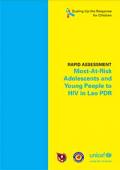What's New
Displaying results 3211 - 3220 of 4052

Resource | Publications,
The findings of this report are a testament to the history and commitment of the Lao PDR Government and its partners to responding to HIV. The Lao PDR Government formally mobilized a response to HIV in 1993. It now has a National Strategic Plan on HIV/AIDS, STI for 2006-2010 and a National Committee for the Control of AIDS with representatives of key Government Ministries. The National Strategic Plan includes targets for universal access to treatment, care and support with international donors, through the Global Fund to Fight AIDS, Tuberculosis and Malaria (GFATM), contributing substantially to this goal.
Adolescents and young people at risk of HIV in Lao PDR include young sex workers, injecting drug users (IDUs), young gay men, other young men who have sex with men (MSM) and transgender people (TG). This report summarizes key issues to be considered in programme design and implementation for most-at-risk adolescents (MARA) and most-at-risk young people (MARYP), and proposes new areas of research on MARA/MARYP.

Resource | Publications,
A key indicator of success of HIV prevention programmes is the number of female sex worker (FSW) sex acts protected by condoms. This measure usually relies on FSW reports, which may be biased. We examined condom availability data in five Karnataka districts to estimate the proportion of FSW sex acts potentially protected by condoms.

Resource | Publications,
Documenting the implementation of a public health programme as per its design is critical to interpretation of results from survey-led outcome and impact evaluation activities, the authors describe the scale-up and coverage of large-scale HIV-prevention services provided to female sex workers (FSWs) and high-risk men who have sex with men (HR-MSM) during the first 5 years of the Avahan programme in India.

Resource | Publications,
Available data on HIV prevalence in Papua New Guinea (PNG) indicates that the country is on the verge of a generalized HIV epidemic. As of March 2010, prevalence among the general population was 0.79% while risk groups have a higher prevalence ranging between 4.3% among men who have sex with men (MSM) and 5.9% among female sex workers (FSW).
The objective of the USAID/FHI behavioral surveillance survey (BSS) was to collect and analyze information about most-at-risk populations (MARPs) in Port Moresby (POM), Papua New Guinea (PNG) in order to better understand how HIV is transmitted in the country; how transactional sex contributes to the HIV epidemic there; and to help assess the outcomes of HIV outreach and prevention efforts.

Resource | Publications,
The National statistics Bureau conducted the Bhutan Multiple Indicator Survey between March and August, 2010. The survey’s main objective is to provide up-to-date information on the situation of children and women in Bhutan. The survey is also aimed at furnishing data required for monitoring progress towards the MDGs, the goals of A World Fit for Children and other international goals. It is hoped that the findings will serve as a basis for equity-based programming, as well as contribute towards the improvement of data and monitoring systems in Bhutan. It will also help to strengthen technical expertise in the design, implementation, and data analysis of similar surveys in future.

Resource | Publications,
The aim of the Vanuatu National Survey on Women's Lives and Family Relationships was to conduct a population-based study to provide a reliable benchmark of the prevalence and incidence of violence against women in Vanuatu, and on attitudes to violence including: health and other effects of violence on women and children; risk and protective factors in the family and the community; coping strategies of women; and the implications for prevention and support services.
This report presents findings from the survey, which was conducted by the Vanuatu Women’s Centre (VWC) in partnership with the Vanuatu National Statistics Office (VNSO) from March to May 2009. This is the first nation-wide study that has been undertaken in Vanuatu on violence against women and attitudes to women’s human rights.

Resource | Publications,
To provide a framework within which to tackle the HIV epidemic, the Government of Papua New Guinea (GoPNG) has recently endorsed the National HIV and AIDS Strategy 2011-2015 (NHS). Although this supersedes the National Strategic Plan on HIV/AIDS 2006-2010 (NSP), it builds upon it to intensify efforts to reduce the transmission of HIV and other sexually transmitted infections (STIs), and to minimise their impact on individuals, families and communities. An NHS Implementation Framework and a National Monitoring and Evaluation Framework provide guidance to partners in developing their annual HIV activity plans and budgets, and in measuring progress in implementing the NHS.
An independent and transparent mechanism for the review of the national response to HIV and AIDS – the Independent Review Group (IRG) – was established in 2007 for an initial three year period to assess performance and to fulfill the Global Task Team’s recommendations for accountability and oversight. The work of the group was extended by the National AIDS Council (NAC) in 2010, for a second three-year period.

Resource | Guidelines,
This document is a direct response to the urgent need to strengthen and expand HIV prevention for MSM and their partners and to improve MSM’s ability to access HIV care and treatment. It furthers PEPFAR’s renewed emphasis on matching interventions and investments with epidemiological trends and needs in order to improve impact. This guidance also builds upon and strengthens international efforts to encourage comprehensive HIV prevention programs for MSM in low- and middle-income countries.

Resource | Fact Sheets,
In April 2011, there were 171 new HIV Ab seropositive individuals confirmed by the STD/AIDS Cooperative Central Laboratory (SACCL) and reported to the HIV and AIDS Registry (Table 1). This was an 11% increase compared to the same period last year (n=154 in 2010) [Figure 1].






